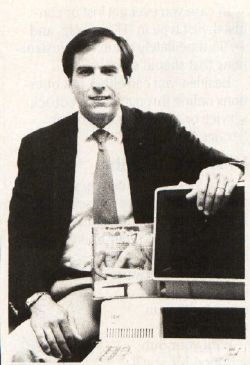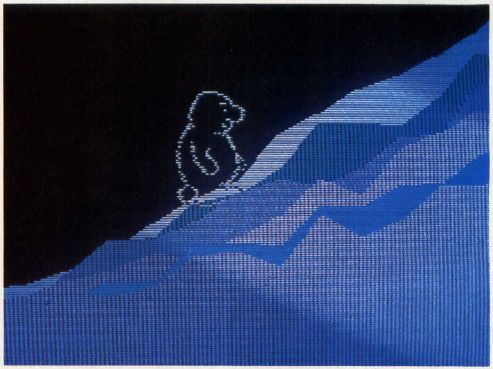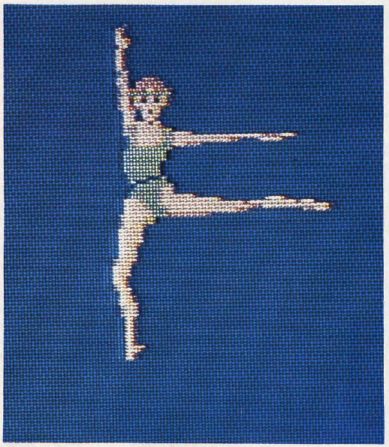The Digital Diet
Staying In Shape With Your Computer
Selby Bateman, Features Editor
How would you like to have your own diet and exercise coach, someone to encourage you to lose those extra pounds, to help schedule your personal fitness program, and to set up a sensible eating plan? A growing number of software companies are taking advantage of the computer's interactive nature to provide these coaches-on-a-disk.
The winter months and holiday season are at hand, the time of year when many of us tend to add pounds that we've struggled to sweat off during the summer. We're all familiar with the drawbacks of being overweight and out of condition, but starting another diet or an exercise routine often seems to demand too much self-discipline. Calorie counting can be a numeric nightmare. And setting up a training schedule means reading more books and articles before getting started.
What if someone else took care of tallying up the calories, suggested alternate diets, planned a personalized workout routine, and even offered encouragement during occasional slips? You could sit down once a day, answer a few questions, and record your progress. Your coach would handle all the tedious calculations, offering you a rich variety of diet options and training schedules. Wouldn't that be easier?
"I wouldn't want to use the word easy. I wouldn't want to tell anybody that losing weight is easy. It isn't. That's why people need strong tools," says Dr. Leigh ton Read, designer of The Original Boston Computer Diet, a weight loss and diet counseling program available for the Commodore 64, Apple II series, and IBM PC/PCjr computers.
Read, an instructor of medicine at Harvard Medical School and a practicing internist, is involved with decision support technologies, computer-assisted research on medical decision-making. His medical and computer interests convinced him that a good interactive computer-based diet program could be far more helpful than the hundreds of diet books on the market. He was also concerned about the health consequences of the many fad diets promoted today.
"The computer can do the computations and the bookkeeping, and that's a big help," he says. "It can do the individualization which a diet book can't, and that's a huge help. But the real power of this new medium, for the developer, is to capture people's imagination to keep them coming back—because losing weight and keeping it off is a long-term issue."

To accomplish all that, Read developed The Original Boston Computer Diet with dietician Cris Carlin, psychiatrist Issac Greenberg, and obesity specialist Dr. George Blackburn. Together they used the latest information on dietetics, behavior modification, and obesity research.
In addition to food reporting, meal planning, and other dieting techniques in The Original Boston Computer Diet, there are also the counselors—George, Amy, and Shirley. Each has a different personality. You choose the counselor you want, and the character guides you through each session, offering suggestions, warnings, encouragement, and even disapproval.
George, for instance, reacts in a matter-of-fact, straightforward way. He can even be a bit stern when you don't follow your plan. Shirley is breezy and freewheeling, and Amy is the sweet counselor who'll help you, but never hurt your feelings. Each counselor follows the same medical and dietary guidelines, but they give different kinds of psychological responses.
"You need to have a long-term compact with a weight-control program," says Read. "If it's dry and uninteresting and strictly a calculator, people aren't likely to have enough exposure to it. So you capture their imagination just a little bit, get them engaged, stimulate their curiosity, and give them a sense that there's a reason to come back to the computer."
The 97-page manual includes readings on exercise, junk food, diet drugs, snacking, eating habits, setting goals, and other related topics. A second booklet contains detailed instructions on food reporting and meal planning. A database in the program, containing a large list of foods normally eaten by Americans, has room for you to add up to 300 additional foods as well. Designed for people who want to lose 10 to 40 pounds, the program also tracks and graphs the dieter's progress. Only one person can use the program at a time, but a second set of disks is available for $10.
Based on the success of The Original Boston Computer Diet, Read feels that he and other developers will be creating many more computer packages for self-improvement, including programs for exercising, managing stress, and quitting smoking.

The Original Boston Computer Diet is by no means the only program of its kind on the market. There are dozens of other packages available for the more than 80 million Americans who are overweight. They range from nutrition education programs for children to sophisticated trackers for adults on restricted diets.
One of the most popular diet books of the last decade, The Complete Scarsdale Medical Diet, has been adapted for the IBM PC and Apple II series. It uses the same Gourmet, International, Vegetarian, Money-Saver, and Basic diets found in the book. A meal-planning calendar helps people schedule their eating patterns. After users choose their menus, the program automatically compiles a shopping list for one or more people. As with the Boston Diet, the food directory is expandable. And the Scarsdale package also analyzes the caloric and nutritional values of the menus, offers guidance on balancing meals, and shows comparisons among different foods.


"This highly successful diet can be custom-tailored to an individual's lifestyle and fitness goals," says Kenzi Sugihara, director of Bantam Electronic Publishing, which sells The Complete Scarsdale Medical Diet. "It's an interactive diet management system that's like having one's own personal diet counselor." Bantam Books also published the paperback version of the book, which is included with the computer program.
Among the attractions of these programs is the custom-tailoring which Sugihara mentions. For example, both programs ask for your current weight, height, frame size, and sex to determine your ideal weight. The Original Boston Computer Diet goes even further, asking such questions as how much you eat, what kinds of foods you eat, how fast you eat, and so on, building a profile of your habits. And both programs have help screens or information windows to guide novice users.
A number of programs are available to teach children the fundamentals of nutrition. The approaches are as varied as the number of packages. For instance, Nutrition Express— designed for youngsters nine years or older—uses a game format. Available for the Apple II series, the program guides players through the imaginary land of FodaFoda. The Fodars ask questions about food and teach about the basic food groups.
Published by the Center for Science in the Public Interest, Nutrition Express teaches children to think about nutrition as they make everyday decisions about food. Consider this sample question: "Beer and soda ads use slim and healthy actors. Do you think the actors got that way by drinking beer or soda pop?"
Another nutrition program for children is Snackmonster: A Nibbler's Dilemma, also for the Apple II series, Commodore 64, and IBM PC/PCjr computers. This educational game tempts youngsters with snacks. If they choose the ones with the lowest calorie count, they win.
The Minnesota Educational Computing Consortium (MECC) offers Food Facts for the Commodore 64 and Apple II series. Food Facts lists the refined sugar content of 64 breakfast cereals, the ingredients in common foods, the time it takes to burn off calories in fast foods, and the percentage of the federal government's recommended daily allowances for eight nutrients in 64 common foods.
Taking yet another approach, Wholebody Health Management publishes Calorie Calculation—Stress, a package for adults that determines the number of calories you need and also helps uncover sources of stress in hypothetical situations. Available for the Commodore 64 and Apple II series computers, the two modules— dealing with calories and stress— can be purchased together or separately.
Closely related to computer diet programs are exercise and fitness packages. While still outnumbered by the diet programs, this software genre shows a strong potential for growth as the packages become more sophisticated and interactive.
Avant-Garde's Be Your Own Coach, for the Commodore 64, Apple II series, and IBM computers, helps joggers keep their own logs, whether it's just a couple of runs a week or training for a marathon. Developed by Robert Lee Smith, a successful marathon runner, triathlete, and coach, the program produces 14 different types of workouts, tailors each workout to your abilities, and prompts you to record mileage, speed, heart rate, weight, and even your feelings after each run. The software also graphs your progress and can forecast pace and mileage progressions.
MECA's The Running Program, subtitled "Your Personal Running Coach," tries a similar angle. It was developed by noted runner and writer James Fixx before his death. The Running Program evaluates your fitness level, sets personal training goals, creates day-by-day training schedules, records and graphs statistics, and predicts your probable performance at different race distances. It is available for IBM computers.
As with the diet programs, the interactivity of the computer gives a more personalized approach to training and recording your workout efforts. Training schedules can be customized and are easily restructured as circumstances change. Should you injure yourself or find that you're overtraining, it's a simple matter to revise the schedules. In fact, both Be Your Own Coach and The Running Program offer guidance when such problems occur.
The popularity of aerobics has been captured in a workout program appropriately called Aerobics. Published by Spinnaker Software for the Atari and Commodore 64 computers, Aerobics is an overall fitness program with a variety of difficulty levels and a choice of musical backgrounds. An onscreen instructor takes you through all the exercises to the accompaniment of music. Different levels and intensities of aerobic exercises are built into the program. You can even choose your own exercises and the order in which you want to do them.
Finally, for the busy executive with an Apple II-series computer, Monument Computer Service publishes Executive Fitness. Suggested exercises are shown onscreen, and harried executives can follow along at their own pace.
As computers grow more powerful and software more sophisticated, diet counselors and fitness coaches on disks will become even more helpful, knowledgeable, and interactive. More and more doctors, coaches, and other health professionals are discovering that computers can become amazingly helpful instructors and guides. But no matter what the goal, says Dr. Leighton Read, most of the effort has to come from you. "The critical issue is the motivation, the planning, and building it into your life," says Read. And even the best computers and programs can go only so far to help you search those goals.



Products and companies mentioned in this article:
Aerobics
Spinnaker Software Co.
1 Kendall Square
Cambridge, MA 02139
Atari 400/800, XL, XE
Commodore 64
$34.95
Be Your Own Coach
Avant-Garde
37-B Commercial Blvd.
Novato, CA 94947
Commodore 64, $39.95
IBM PC/PCjr (128K RAM), $49.95
Apple II series (64K RAM), $49.95
Calorie Calculation—Stress
Wholebody Health Management
18653 Ventura Blvd.
Suite 137
Tarzana, CA 91356
Apple II series (48K RAM)
Commodore 64
$19.95 for Stress disk
$16 for Calorie Calculation disk
$25 for both
The Complete Scarsdale Medical Diet
Bantam Electronic Publishing
Bantam Books, Inc.
666 Fifth Avenue
New York, NY 10103
Apple II series (48K RAM)
IBM PC/PCjr (128K RAM)
$39.95
Executive Fitness
Monument Computer Service
Village Data Center
P.O. Box 603
Joshua Tree, CA 92252
Apple II series (48K RAM)
$19.95
Food Facts
MECC
3490 Lexington Avenue N.
St. Paul, MN 55112
Apple II series (48K RAM)
Commodore 64
$45
Nutrition Express
Center for Science in the Public Interest
1501 16th St. N.W.
Washington, D.C. 20036
Apple II series (48K RAM)
$39.95
The Original Boston Computer Diet
Scarborough Systems, Inc.
55 S. Broadway
Tarrytown, NY 10591
Commodore 64, $49.95
Apple II series (64K RAM), $79.95
IBM PC/PCjr (128K RAM), $79.95
The Running Program
MECA
285 Riverside Avenue
Westport, CT 06880
IBM PC (128K RAM), PCjr (256K RAM),
$79.95
Snackmonster: A Nibbler's Dilemma
The Learning Seed Co.
21250 N. Andover Road
Kildeer, IL 60047
Apple II series (48K RAM)
IBM PC/PCjr (64K RAM)
Commodore 64
$49
